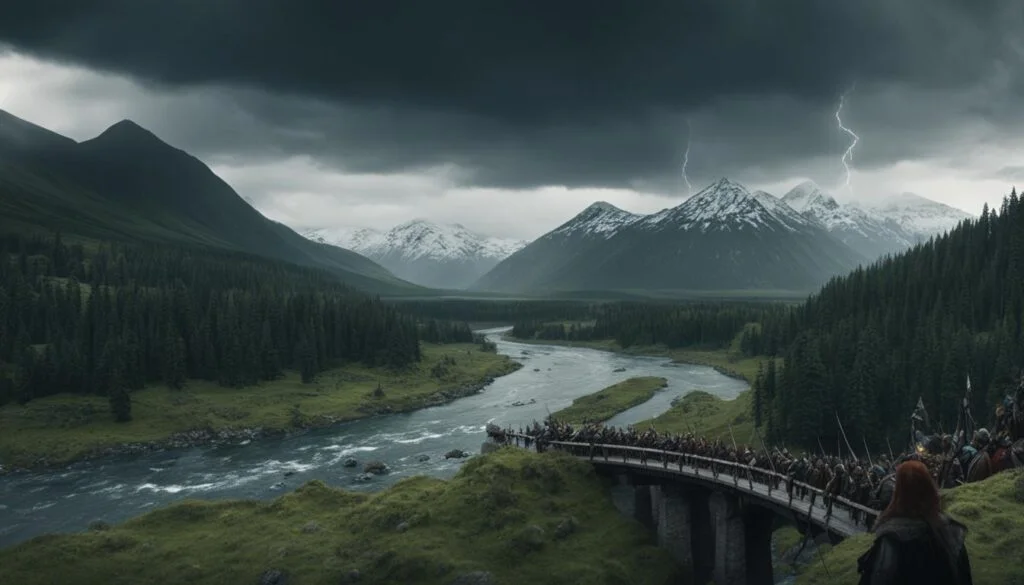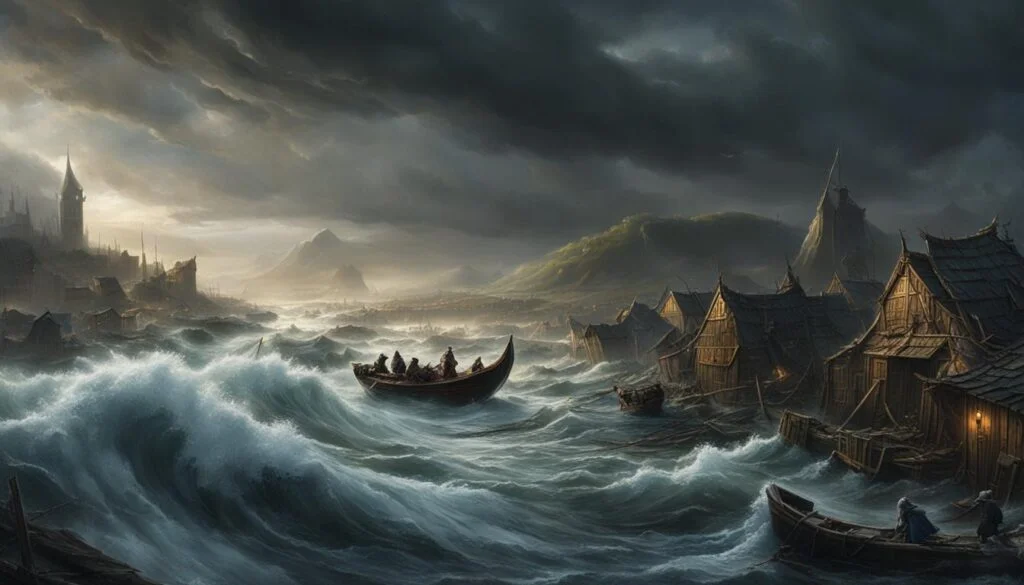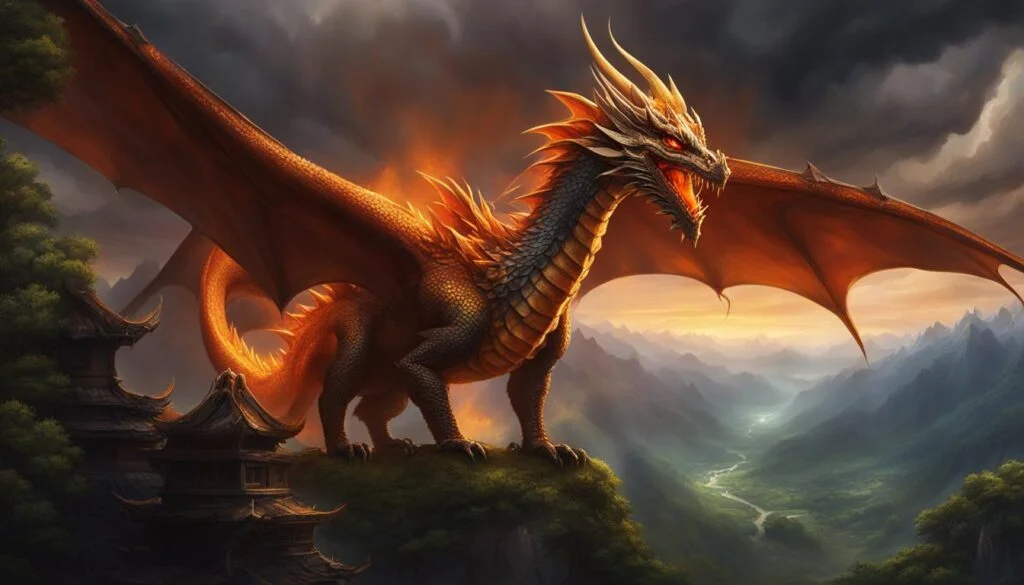Welcome to our exploration of Midgard, one of the nine worlds in Norse mythology. In this article, we will delve into the meaning, significance, and origins of Midgard, as well as its connection to the other realms and its role in Norse cosmology. So, let’s embark on this fascinating journey into the realm of humans.
Midgard, which translates to “middle enclosure,” is the earthly realm inhabited by humans. Situated below Asgard, the realm of the Aesir gods, Midgard is connected to the divine realm by Bifröst, the rainbow bridge. It holds a central position in the vertical order of the Nine Realms, representing a realm striving for law and order.
In Norse mythology, the creation of Midgard is attributed to the union of the melting ice from Niflheim and the sparks from Muspelheim in Ginnungagap, the primordial void. This interaction gave birth to Ymir, the first giant, whose body was used to form the realms, with his flesh becoming Midgard.
Midgard’s significance lies in its connection to Asgard and its position in the cosmic order. It represents the human realm, where mortals interact with gods, giants, and other mythological beings. Midgard’s connection to the World Tree Yggdrasil further emphasizes its integral role in the overall mythology.
Throughout Norse mythology, Midgard serves as the stage for epic tales, heroic sagas, and the ultimate fate of Ragnarok, the apocalyptic event. It continues to captivate our imagination in modern interpretations, portraying it as a realm of adventure and resilience.
Key Takeaways:
- Midgard is one of the nine worlds in Norse mythology, representing the realm of humans.
- It is connected to Asgard, the realm of the gods, by Bifröst, the rainbow bridge.
- The name “Midgard” translates to “middle enclosure” and signifies its position in the cosmic order.
- Midgard was created when the ice from Niflheim and the sparks from Muspelheim merged in Ginnungagap.
- It plays a crucial role in Norse cosmology, representing the human condition and the struggles faced in the mortal world.
The Nine Realms of Norse Mythology
In Norse mythology, the cosmos is divided into nine realms, each with its own distinct characteristics and inhabitants. These realms are connected by Yggdrasil, the World Tree, which serves as the axis of the cosmic order.
Asgard
Asgard is the realm of the Aesir gods, known for their power and wisdom. It is a divine realm associated with strength, valor, and the pursuit of justice.
Vanaheim
Vanaheim is the realm of the Vanir gods, associated with fertility, nature, and abundance. It is a realm of beauty and harmony.
Jotunheim
Jotunheim is the land of the giants, a realm characterized by vast wilderness and formidable beings. It is a realm of chaos and conflict.
Alfheim
Alfheim is the realm of the elves, known for their grace and enchantment. It is a realm of light and magic, where beauty and artistry flourish.
Nidavellir
Nidavellir is the home of the dwarves, skilled craftsmen and creators of magical artifacts. It is a realm rich in precious metals and underground wonders.
Midgard
Midgard, also known as Earth, is the realm of humans. It is situated between the divine realms and the chaotic realms, symbolizing the human condition and the struggles faced in the mortal world.
Muspelheim
Muspelheim is a realm of fire and heat, inhabited by fire giants and demons. It is a realm of destruction and primal forces.
Niflheim
Niflheim is a realm of ice and fog, associated with darkness and cold. It is a realm of death and the source of many rivers.
Helheim
Helheim is the realm of the dead, ruled by the goddess Hel. It is a realm of shadows and silence, where those who die of old age and illness end up.
These nine realms form a complex and interconnected cosmology in Norse mythology, each contributing to the rich tapestry of this ancient belief system.
The Creation of Midgard
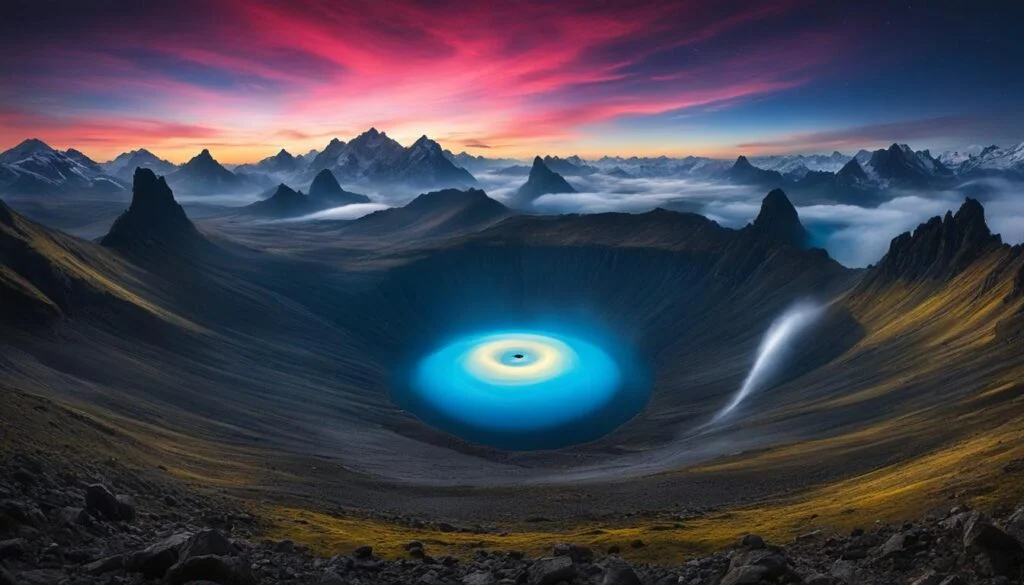
According to Norse mythology, Midgard, the realm of humans, has a fascinating origin story. It all began when the icy realm of Niflheim and the fiery realm of Muspelheim collided in Ginnungagap, the primordial void.
As the ice from Niflheim melted and the sparks from Muspelheim ignited, a giant named Ymir and a primordial cow named Audhumla emerged from the chaos. Ymir, the first giant, fed on Audhumla’s nourishing milk, sustaining his existence.
In an extraordinary turn of events, Ymir’s body was used to create the various realms of Norse mythology. His flesh became the very fabric of Midgard, the realm of humans. This pivotal moment marked the birth of humanity and their distinct place within the mythological cosmos.
This myth about the creation of Midgard showcases the intricate interplay between opposing forces and the emergence of order from chaos. It illustrates the significance of humans in Norse mythology and highlights the unique connection between Midgard and the realms of gods, giants, and other mythological beings.
Midgard’s origin story is a testament to the rich and complex mythology of the Norse tradition. It sets the stage for the epic tales and adventures that unfold in this realm, shaping the destiny of both mortal and divine beings.
Midgard – The Realm of Humans
Midgard, also known as Earth, is the realm exclusively inhabited by humans in Norse mythology. It holds a significant place within the cosmic Nine Realms and serves as the human realm in the mythological cosmos.
The name “Midgard” translates to “middle enclosure,” highlighting its central position between the divine realms and the chaotic realms. Midgard is believed to be the realm where humans, the central focus of the Norse cosmos, reside and interact with other beings from different realms.
While humans in Norse mythology may encounter gods, giants, elves, and other mythological creatures, Midgard remains their home and holds immense importance. It represents the human condition, their struggles, aspirations, and the unique role they play within the larger mythological tapestry.
- Midgard is the bridge between the worlds, connecting humans to the realms of gods and chaotic forces.
- Being the realm of humans, Midgard symbolizes the aspirations, challenges, and triumphs of the mortal life.
- Humans in Norse mythology have the ability to impact the fate of the cosmos through their actions in Midgard.
- Midgard’s position between the divine and chaotic realms emphasizes its significance in the overall cosmology of Norse mythology.
Midgard provides a unique perspective to explore the human experience and serves as a reminder of the delicate balance between order and chaos in the Nine Realms. It is a realm thriving on the dreams, ambitions, and struggles of humanity, making it an integral part of Norse mythology.
Midgard’s Connection to Asgard
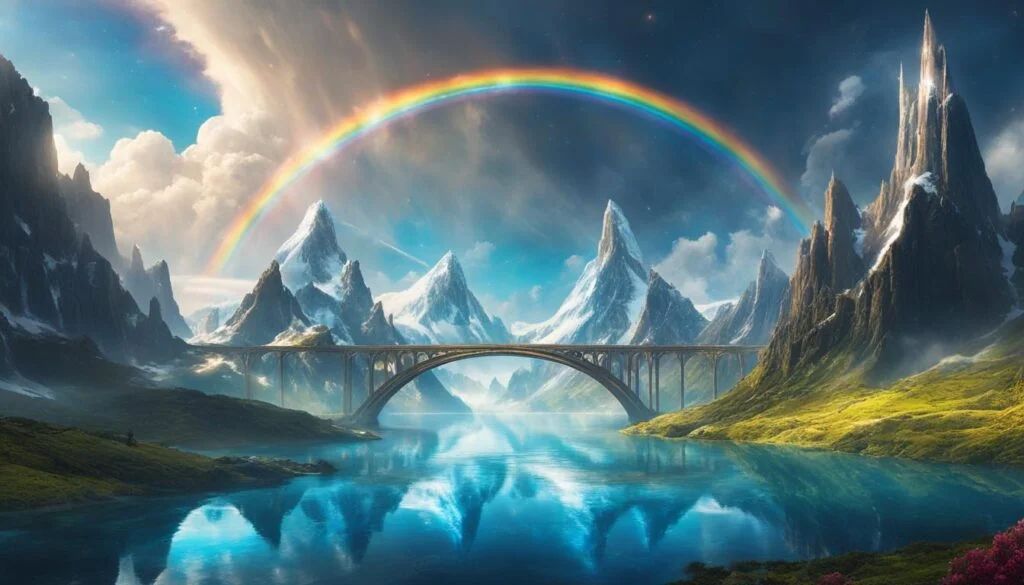
Midgard, the realm of humans in Norse mythology, shares a deep connection with Asgard, the realm of the gods. This connection is bridged by Bifröst, the majestic rainbow bridge that spans the gap between the two realms.
Bifröst serves as a vibrant and awe-inspiring passage, allowing the gods, goddesses, and other beings to travel freely between Midgard and Asgard. This connection symbolizes the profound relationship and interaction between humans and the divine.
The responsibility of guarding Bifröst falls upon the mighty god Heimdall, who possesses exceptional vision and hearing. He stands as the sentinel, constantly vigilant, watching over the bridge and ensuring the security of the realms.
The rainbow bridge connecting Midgard and Asgard encapsulates the essence of the intricate bond between mortals and deities. It represents the pathway through which divine influence flows into the human realm and vice versa.
Let us visualize the magnificent Bifröst that unites Midgard and Asgard:
Midgard’s Significance in Norse Cosmology
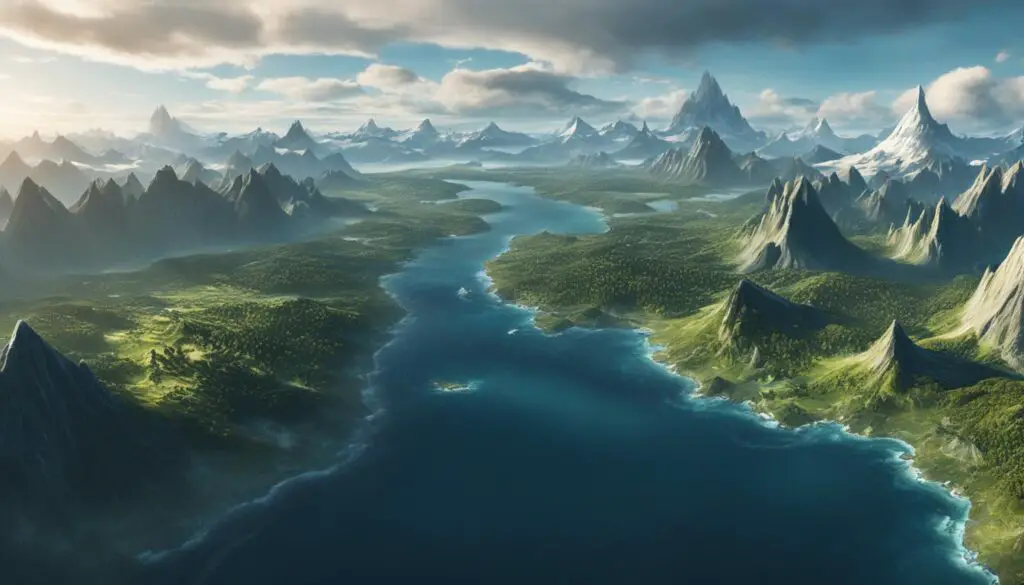
Midgard plays a central role in Norse cosmology as the realm of humans. It holds great importance in the overall mythology, serving as the bridge between the divine realms and the chaotic realms. This earthly realm is believed to be the domain where gods and humans can interact and coexist, making it a crucial space for the unfolding of mythological events.
In Norse mythology, Midgard represents the human condition and the struggles faced in the mortal world. It embodies the essence of humanity and serves as a reminder of the challenges and triumphs experienced by humans. Midgard’s position in the order of the Nine Realms positions it at the center of the cosmic hierarchy, highlighting its significance as a central realm in Norse cosmology.
The connection between Midgard and Asgard, the realm of the gods, further emphasizes its importance. The rainbow bridge Bifröst serves as a vibrant passage linking these two realms, enabling the interaction between humans and divine beings. This connection symbolizes the intricate relationship between mortals and immortals, showcasing the interplay of power and vulnerability.
The shared existence between gods and humans within Midgard showcases the dynamic nature of the Norse cosmos. It portrays the interdependence and mutual influence between these two realms, offering insights into the complex tapestry of Norse mythology.
The Role of Midgard in Norse Mythology
- Serves as the realm of humans in the cosmic Nine Realms.
- Bridges the gap between the divine realms and the chaotic realms.
- Represents the human condition and the struggles faced in the mortal world.
- Holds a central position in the order of the Nine Realms.
- Allows for interaction and shared existence between gods and humans.
Midgard and the World Tree Yggdrasil
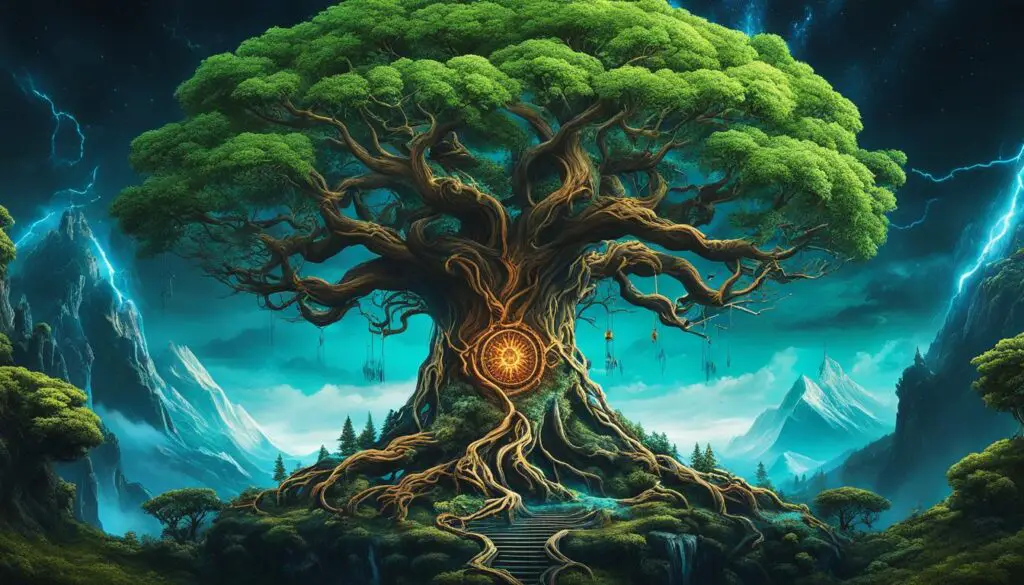
Midgard, the realm of humans in Norse mythology, is intricately connected to the World Tree Yggdrasil. Yggdrasil, a massive ash tree, stands at the center of the Nine Realms, serving as the axis of the cosmos. With its roots spanning different realms, including Midgard, and its branches reaching into the sky, Yggdrasil acts as a bridge between the mortal realm and the divine.
Yggdrasil provides stability and structure to the cosmos, influencing the fate and interconnectedness of all beings. Its connection to Midgard highlights the importance of humans in the Norse mythology narrative. As Midgard represents the human realm, the well-being of Midgard is believed to be closely tied to the well-being of Yggdrasil itself.
Just as the roots of Yggdrasil draw nourishment from different realms, the connection between Midgard and the World Tree demonstrates the inherent relationship between humans and the larger mythological framework. Midgard’s existence and significance are intricately woven into the fabric of Yggdrasil and the cosmic order it represents.
Legends and Stories of Midgard
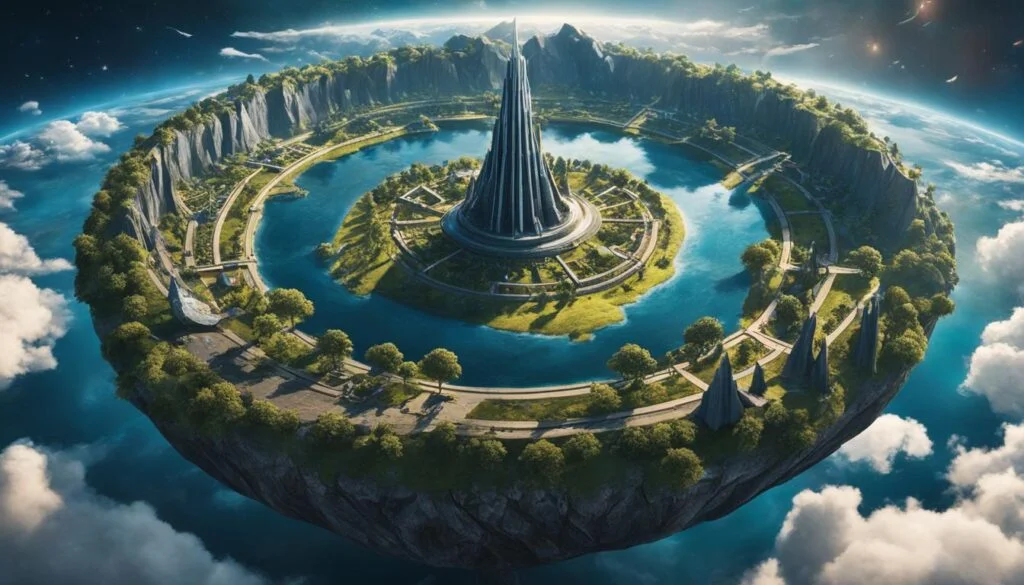
Midgard, the realm of humans in Norse mythology, is brimming with captivating myths and legends. It serves as the stage where heroic sagas unfold, and where mortals interact with gods, giants, and other mythical beings. Midgard is a realm filled with epic battles, quests, and the forging of alliances. Let’s explore some of the notable events and captivating stories that take place in Midgard.
Creation of the First Humans
One of the prominent myths associated with Midgard is the creation of the first humans. According to Norse mythology, the gods crafted the first humans, Ask and Embla, from two trees – an ash tree and an elm tree. The gods breathed life into these humanoid forms, gifting them with the ability to reason and make choices. This myth reinforces the connection between Midgard and humanity, emphasizing humans’ unique place in the cosmos.
The Adventures of Gods and Heroes
Midgard provides the backdrop for countless adventures featuring gods and heroes. These tales often involve gods assuming mortal forms and embarking on quests, disguising themselves to interact with humans. One such famous legend is the story of Thor’s journey to Jotunheim, the land of giants. Thor, the god of thunder, and his companions face numerous challenges and engage in epic battles as they navigate the treacherous giant realm, showcasing the heroism and strength of the gods.
The Ultimate Fate of Midgard – Ragnarok
In Norse mythology, Midgard’s fate is intertwined with the cataclysmic event known as Ragnarok. During Ragnarok, the realm of Midgard becomes a battleground where gods and mythical creatures clash in an apocalyptic war. The event marks the end of the current world order and the ushering in of a new era. Midgard’s fate in Ragnarok underscores the cyclical nature of existence in Norse mythology, where destruction paves the way for rebirth.
These are just a glimpse of the captivating legends and stories that unfold in Midgard. Its rich folklore weaves together tales of heroism, divine intervention, and the epic struggles between gods and mortals. Midgard’s significance in Norse mythology is undeniable and continues to inspire modern retellings, preserving the enduring allure of this realm in the collective imagination.
Midgard’s Role in Ragnarok
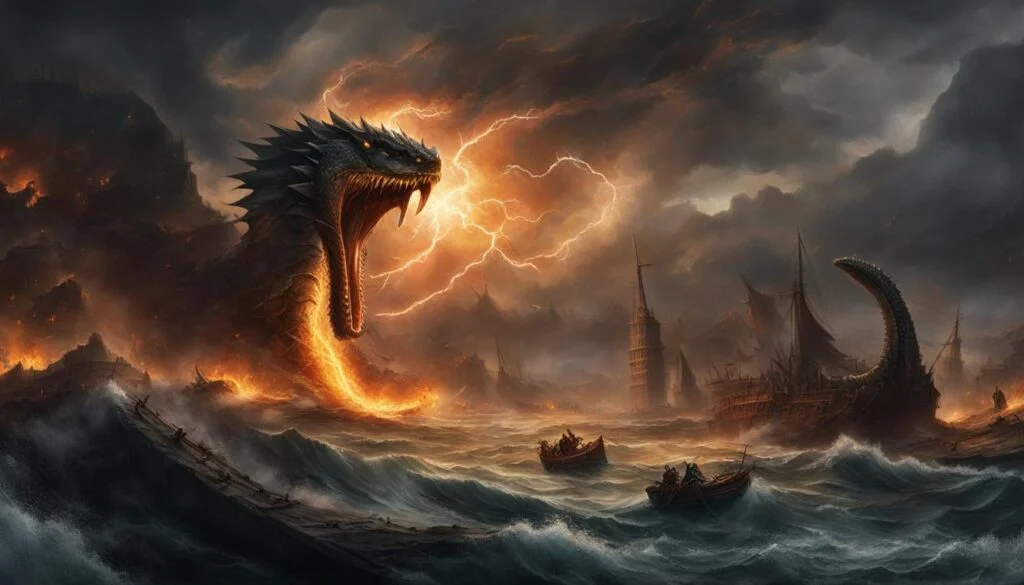
Midgard, the realm of humans in Norse mythology, has a significant role in the apocalyptic event known as Ragnarok. This cataclysmic event marks the end of the current world order and the beginning of a new cycle. During Ragnarok, Midgard is destined to face destruction, bringing forth an era of chaos and rebirth.
According to the prophecy, the giant Surtr will unleash powerful flames upon Midgard, engulfing the realm in fire and destruction. This fiery cataclysm symbolizes the end of the human realm and serves as a representation of the cyclical nature of existence in Norse mythology.
Ragnarok marks the ultimate battle between the gods and the forces of chaos, with Midgard becoming a battlefield in this monumental clash. The destruction of Midgard signifies the underlying themes of chaos, destruction, and transformation deeply ingrained in Norse mythology.
However, amidst the destruction and chaos, Ragnarok also paves the way for a new beginning. The destruction of Midgard signifies the end of the old world and the opportunity for a fresh start. From the ashes of destruction, a new world will emerge, and the cycle of life will continue.
The role of Midgard in Ragnarok showcases its significance as a central realm in Norse mythology, representing the human condition and the cyclical nature of existence. It emphasizes the balance between order and chaos, and the transformative power of destruction and rebirth.
The Destruction of Midgard in Norse Mythology
The prophecy of Ragnarok foretells the destructive fate that awaits Midgard. As the flames of Surtr’s fury engulf the realm, the once vibrant and thriving human realm succumbs to devastation. The destruction of Midgard serves as a powerful symbol of the ultimate end of all things, reinforcing the fundamental principle of impermanence in Norse mythology.
While the destruction of Midgard may seem bleak, it is important to remember that Norse mythology also emphasizes the cyclical nature of existence. With the destruction comes the potential for rebirth and the opportunity for a new world to arise. This cyclical pattern pervades all aspects of Norse mythology, highlighting the interconnectedness of life, death, and renewal.
In conclusion, Midgard’s role in Ragnarok showcases its significance as the realm of humans and the bridge between the divine and chaotic realms. The destruction of Midgard during Ragnarok represents the cyclical nature of existence, where chaos and rebirth are intertwined. It serves as a powerful reminder of the impermanence of all things and the transformative power of destruction. Through the destruction of Midgard, a new world arises, signifying the potential for renewal and the continuation of the cosmic cycle in Norse mythology.
Midgard in Modern Interpretations
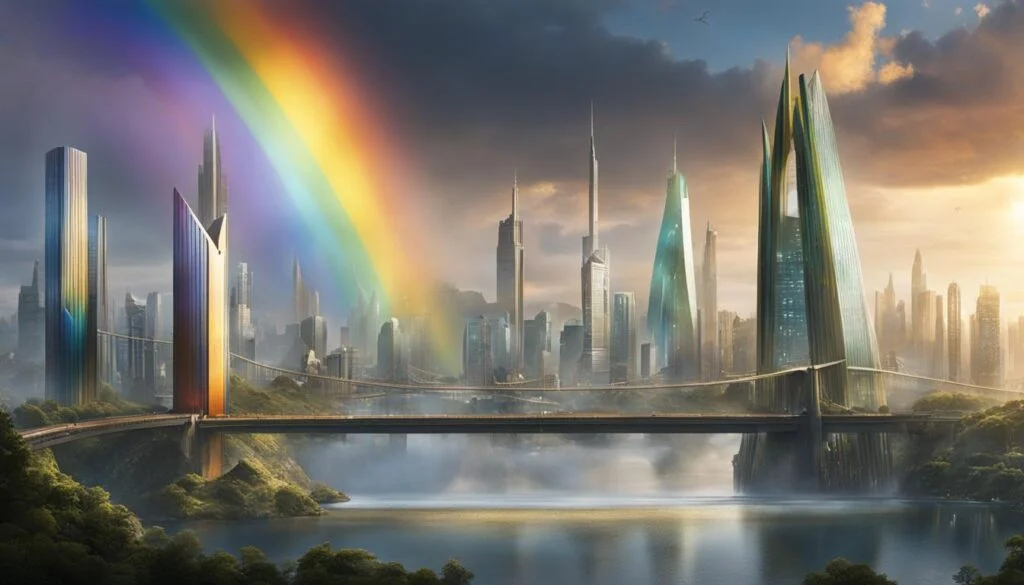
Midgard, the realm of humans in Norse mythology, continues to captivate the imagination of people in modern times. Its portrayal in popular culture through movies, books, and video games has played a crucial role in introducing Norse mythology to a wider audience.
In these modern interpretations, Midgard is often depicted as a realm of adventure, resilience, and the indomitable human spirit. It serves as a stage for epic tales and heroic sagas, where humans interact with gods, giants, and other mythological beings.
One significant aspect of Midgard’s portrayal is its connection to Asgard, the realm of the gods. This connection highlights the themes of heroism, destiny, and the interaction between mortals and divinity. Midgard represents the human condition and the struggles faced in the mortal world, resonating with audiences who are drawn to stories of overcoming adversity and discovering one’s true potential.
Midgard’s significance in modern retellings lies in its timeless themes and its reflection of the enduring fascination with Norse mythology. The rich lore and mythology of Midgard continue to inspire and captivate storytellers, who use its portrayal as a means to explore the complexities of human existence and the realms beyond.
From blockbuster movies to bestselling books, Midgard’s presence in popular culture keeps Norse mythology alive and relevant. Its portrayal serves as a gateway to a realm of wonder, adventure, and the exploration of the human experience in the context of ancient mythology.
Conclusion
Midgard, the realm of humans in Norse mythology, holds great significance as it embodies the human condition and the struggles faced in the mortal world. Positioned as the middle enclosure and connected to Asgard, the realm of the gods, Midgard acts as a bridge between the divine and chaotic realms. This connection highlights the interaction and relationship between humans and the gods, represented by the rainbow bridge Bifrost.
Midgard’s central role in the order of the Nine Realms and its portrayal as the realm of humans make it a focal point in Norse cosmology. It is the stage for epic tales, heroic sagas, and the ultimate fate of Ragnarok, the apocalyptic event that marks the end of the current world order. Midgard’s enduring appeal is evident through its depiction in popular culture, which further reinforces the timeless themes of adventure, resilience, and the human spirit it embodies.
In summary, Midgard holds a key position in Norse mythology, acting as the realm for humans and playing a crucial role in the larger cosmic framework. While its portrayal may vary in modern interpretations, its importance as the human realm and its connection to Asgard remain constant. Midgard serves as a reminder of the inherent struggles and triumphs of the mortal world, making it an integral part of the intricate tapestry of Norse mythology.
FAQ
What is Midgard in Norse mythology?
Midgard is one of the nine worlds in Norse mythology, known as Earth in the cosmic Nine Realms. It is the realm inhabited by humans and is situated below Asgard, the realm of the Aesir gods.
What are the nine realms in Norse mythology?
The nine realms in Norse mythology are Asgard, Vanaheim, Jotunheim, Alfheim, Nidavellir, Midgard, Muspelheim, Niflheim, and Helheim. Each realm has its own characteristics and inhabitants.
How was Midgard created in Norse mythology?
According to Norse mythology, Midgard was created when the melting ice from Niflheim and the sparks from Muspelheim met in Ginnungagap, the primordial void. This interaction resulted in the creation of Ymir, the first giant, and Audhumla, the primordial cow. Ymir’s body was then used to form the realms, with his flesh becoming Midgard.
What is the significance of Midgard in Norse cosmology?
Midgard holds a central role in Norse cosmology as the realm of humans. It represents the earthly realm that bridges the gap between the divine realms and the chaotic realms. Midgard’s position and connection to Asgard highlight its importance in the overall mythology.
How is Midgard connected to Asgard?
Midgard is connected to Asgard, the realm of the gods, by Bifröst, the rainbow bridge. This connection allows the gods and other beings to travel between the realms. Bifröst serves as a vibrant passage, symbolizing the interaction and relationship between humans and the gods.
What is the role of Midgard in the mythology of Ragnarok?
Midgard plays a significant role in the mythological event known as Ragnarok. During Ragnarok, Midgard is destined to be destroyed by fire brought about by the giant Surtr. The destruction of Midgard represents the end of the current world order and the beginning of a new cycle.
What are some notable stories and legends about Midgard in Norse mythology?
Midgard is the backdrop for various myths and legends in Norse mythology. It is the realm where heroic sagas unfold, and where humans interact with gods, giants, and other mythological beings. Midgard is the stage for epic battles, quests, and the forging of alliances.
How is Midgard portrayed in modern interpretations of Norse mythology?
Midgard continues to captivate the imagination of people in modern times. Its depiction in popular culture reflects themes of adventure, resilience, and the human spirit. Midgard’s connection to Asgard and its role as the human realm resonate with the enduring fascination of Norse mythology.
What are the key takeaways about Midgard in Norse mythology?
Midgard is the realm of humans in Norse mythology, situated below Asgard and connected by Bifröst. It holds a significant place in the cosmology of Norse mythology as the bridge between the divine and chaotic realms. Midgard’s destruction in Ragnarok represents the cyclical nature of existence.


